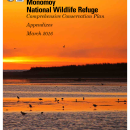What We Do
Migratory bird research and monitoring
Refuge biologists and partners conduct annual censuses of common, least, and roseate terns, as well as piping plovers, American oystercatchers, wading birds, and gulls. They also capture, band, and re-sight many bird species to track return and survival rates, as well as deploy transmitters to assess fine-scale movements. These data allow the Service and its partners to make informed conservation decisions locally and on a flyway/hemispheric scale.
Horseshoe crab surveys and tagging
Each spring and early summer, staff and volunteers survey and tag individual horseshoe crabs to assess relative abundance and movements. The U.S. Fish and Wildlife Service also keeps track of previously tagged individuals using a call-in system. The phone number (1-888-546-8587) is written on the tag itself -- but remember, never pick up a horseshoe crab by its tail, as you may injure it. Because horseshoe crabs are protected throughout Refuge lands and waters, Monomoy supports a highly productive population of this species; whose eggs are critical to migratory shorebirds.
Gray Seals
Monomoy NWR actively supports seal research each year to better understand seal ecology, population structure structure
Something temporarily or permanently constructed, built, or placed; and constructed of natural or manufactured parts including, but not limited to, a building, shed, cabin, porch, bridge, walkway, stair steps, sign, landing, platform, dock, rack, fence, telecommunication device, antennae, fish cleaning table, satellite dish/mount, or well head.
Learn more about structure , movement rates, and diet.
Northeastern Beach Tiger Beetle
The federally threatened northeastern beach tiger beetle requires undisturbed sandy habitats free of heavy foot and vehicle traffic, such as those found on Monomoy. These insects live along the Atlantic coastline from Cape Cod to New Jersey, as well as along the Chesapeake Bay. Reintroduction to South Monomoy Island. A reintroduction project began when 23 larvae from Martha’s Vineyard were transplanted to South Monomoy in May of 2000. A second transplant released 34 more larvae. This trend was continued annually until 2004. The project has been highly successful, with a current population well in excess of 8,000 individuals. As northeastern beach tiger beetles are indicators of a healthy beach community, their success is highly significant for Monomoy NWR’s ecosystem. In 2021, 50 tiger beetle specimens were collected for a reintroduction project that is taking place in New Jersey.
Management and Conservation
Comprehensive Conservation Planning
The purpose of a comprehensive conservation plan (CCP) is to guide refuge management over the next 15 years. The plan includes goals, objectives, and strategies for refuge programs, and details the combination of actions we will implement to protect species, manage habitats, and support compatible, public recreational and other uses.
CCP Status
The U.S. Fish and Wildlife Service (Service) released a comprehensive conservation plan (CCP) that will guide management of Monomoy National Wildlife Refuge for 15 years. The Service’s Northeast Regional Director approved the final plan and issued a Record of Decision on March 18, 2016.
The management decisions included in the CCP are a result of thorough environmental review and input from State agencies, the town of Chatham, local residents, conservation partners, and other stakeholders. Both a draft and final CCP/environmental impact statement (EIS) were published for public review and comment. The CCP adopts alternative B from the final CCP/EIS for implementation with several minor changes incorporated.
Our Projects and Research
Shorebird Disturbance
For 2024 we will be highlighting our efforts to minimize shorebird disturbance as these birds have seen a continued decline in shorebird populations. The goal is to reduce the disturbance of migratory shorebirds on refuge owned or managed beaches. This will be accomplished by increasing the presence of trained personnel (staff, interns, or volunteers) on refuge beaches, improve communications about the issue, and observe positive or negative impacts to shorebirds to inform management decisions.

